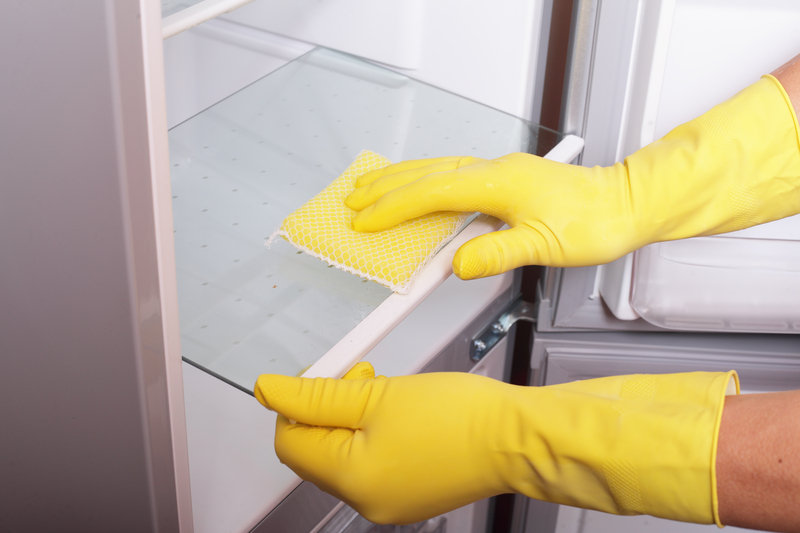Step-By-Step Removal of Mould from Window Sills
Posted on 16/06/2025
Step-By-Step Removal of Mould from Window Sills: A Comprehensive Guide
Mould growth on window sills is a common issue in homes and offices, especially in areas with high humidity and poor ventilation. Learning the step-by-step removal of mould from window sills will not only maintain the aesthetic appeal of your home but also preserve your indoor air quality. In this in-depth guide, we'll walk you through removing mould safely and effectively, preventing its return, and ensuring your family's health is protected.

What Causes Mould on Window Sills?
Before diving into solutions, it's crucial to understand why mould grows on window sills. Mould thrives in moist, dark, and warm environments. Common causes include:
- Condensation: Cold window panes attract warm, moist air, creating condensation that makes sills damp--ideal for mould!
- Poor Ventilation: Insufficient airflow prevents moisture from evaporating, resulting in a mould-friendly environment.
- Water Leakage: Leaky windows let rainwater in, leading to chronic dampness.
- Old Windows: Aging window frames may not seal properly, increasing moisture intrusion.
Why Is Mould on Window Sills a Problem?
- Health risks: Mould spores can trigger allergies, asthma attacks, and other respiratory problems--especially dangerous for vulnerable groups.
- Home damage: Mould feeds on organic materials, weakening wood and paint, leading to costly repairs.
- Unpleasant odour: A musty smell can permeate living spaces.
Step-by-step mould removal from window sills is essential not only for visual cleanliness but also for your overall health and home maintenance.
Tools and Supplies You'll Need
Gather these items for effective window sill mould removal:
- Protective gloves (latex or rubber)
- Face mask or respirator
- Protective eyewear
- Old clothes or disposable coveralls
- Soft-bristle brush or old toothbrush
- Microfiber cloths
- Spray bottle
- Bowl or bucket
- Dish soap
- White vinegar or hydrogen peroxide
- Baking soda
- Commercial mould remover (optional)
- Paper towels or absorbent cloths
- Vacuum with HEPA filter (optional)
Precautionary Measures Before Removal
- Ventilate the room by opening windows and doors to avoid inhaling mould spores.
- Wear protective gear to prevent skin and lung exposure.
- Keep pets and children away from the affected area.
- Avoid dry brushing mould, as it can release spores into the air.
Tip: Always test your cleaning product on a small, inconspicuous area of the window sill first.
Step-By-Step Removal of Mould from Window Sills
Step 1: Remove Loose Mould Spores
- Vacuum: Use a vacuum cleaner with a HEPA filter to gently remove loose spores from the window sill and frame. Dispose of the vacuum bag or clean the filter outdoors.
- Wipe: Use a damp (not wet) cloth to further wipe down the area and collect stray spores.
Step 2: Prepare Your Cleaning Solution
- Mix a solution of one-part white vinegar and one-part water in a spray bottle. Alternatively, you can use undiluted hydrogen peroxide (3%) for stubborn mould.
- For heavy growth, sprinkle a little baking soda directly onto mould patches before spraying.
- A commercial mould remover is also effective, but check that it's safe for your window material.
Step 3: Apply the Cleaning Solution
- Spray your chosen solution generously onto the affected areas of the window sill and frame.
- Let it sit for 10-15 minutes to penetrate and kill the mould at its roots.
Step 4: Scrub Away the Mould
- Using a soft-bristle brush or old toothbrush, scrub the window sill gently yet thoroughly.
- Pay attention to cracks, corners, and hard-to-reach places where mould spores like to hide.
- For persistent mould, reapply the cleaning solution and repeat the scrubbing.
Step 5: Clean Up Residue
- Wipe away dissolved mould and cleaning solution using a clean, damp microfiber cloth.
- Follow with a dry cloth to remove leftover moisture and prevent further mould growth.
- Dispose of all used cloths, sponges, and paper towels safely by sealing them in a plastic bag before discarding.
Step 6: Dry the Surface Thoroughly
- Moisture is mould's best friend. Open windows and consider using a fan or hair dryer to ensure the sill and frame are completely dry.
Step 7: Repeat as Necessary
- If you notice remaining stains after drying, repeat the process (steps 2-6) until the surface is clean and mould-free.
Natural vs. Chemical Mould Removers
There are different approaches to window mould cleaning. Here's how they compare:
- Natural Remedies: Vinegar, hydrogen peroxide, and baking soda are non-toxic and effective for most household moulds.
- Chemical Cleaners: Commercial mould removers work faster on stubborn or toxic moulds (like black mould), but require good ventilation and strict safety precautions.
Never mix bleach with ammonia or vinegar--the combination produces toxic gases.
Preventing Mould From Returning to Window Sills
Once you've completed the step-by-step removal of mould from window sills, focus on prevention:
- Improve ventilation: Open windows regularly or use extract fans, particularly in kitchens and bathrooms.
- Wipe condensation daily from glass panes and sills, especially during colder months.
- Use a dehumidifier to keep indoor humidity below 60%.
- Check for leaks and repair damaged window seals and caulking promptly.
- Move furniture away from windows to allow air to circulate.
- Apply anti-mould or fungicidal paint to sills and frames for added protection.
- Regular cleaning: Make mould inspection and cleaning part of your household routine.
When to Call a Professional
While DIY window mould cleaning is effective in most cases, sometimes you need the pros:
- Mould covers an area larger than 1m? (10 square feet)
- Mould appears inside wall cavities or insulation
- You experience persistent health symptoms
- There's a musty smell without visible mould
- The problem keeps returning after cleaning and addressing moisture issues
A certified mould remediation specialist can identify hidden sources, contain spore spread, and restore your home safely.

Frequently Asked Questions About Mould on Window Sills
- Can I use bleach to remove mould from window sills?
- Bleach kills some surface moulds but is not recommended for porous materials like wood. Vinegar or hydrogen peroxide are preferable options that also address root-level growth.
- How often should I check my window sills for mould?
- Monthly inspections are ideal, especially in winter or humid seasons.
- Is black mould on my window frame dangerous?
- Stachybotrys (toxic black mould) can be dangerous. If you suspect it, avoid contact and seek professional help.
- Does painting over mould stop it?
- No, painting over mould may hide it, but the growth continues underneath. Always clean and remove mould completely before painting.
Conclusion: Say Goodbye to Mould on Your Window Sills!
The step-by-step removal of mould from window sills is essential for a safe, healthy, and pleasant living environment. By following this guide--gathering the right tools, using effective solutions, and taking preventative measures--you can eliminate even stubborn window sill mould problems.
Regular cleaning, good airflow, and moisture control are your best allies in keeping your window sills mould-free for good. If you encounter significant or persistent mould, don't hesitate to call in professionals to safeguard your home and health.
Ready to restore your space? Tackle window sill mould today with these proven steps, and breathe easier knowing your home is clean and protected!



